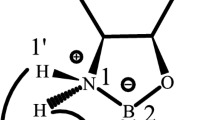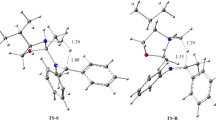Abstract.
The reduction of ketones by borane (BH3) using the Corey, Bakshi and Shibata (CBS) catalyst is an important tool in asymmetric synthesis. In a theoretical study of the reduction of acetophenone, substantial differences emerged depending on the method and basis set adopted. Therefore, in this work, the weak interaction responsible for the formation of the acetophenone-CBS complex was studied for model systems, with the aim to find the best compromise between the quality of the interaction description achieved and computational costs. The main model chosen for the study contained the most important elements of the acetophenone-CBS-BH3 complexes: the 1,3,2-oxazaborolidine ring, with molecules of BH3 and acetone (the smallest possible ketone) coordinated to it. The effect of basis set and method on the description of the ketone-oxazaborolidine interaction along the BO approach path was investigated via several methods (HF, DFT-B3LYP, MP2) and basis sets (3–21G, 6–31G, 6–31G*, 6–31G**, 6–31+G**), taking into account basis set superposition errors, which can be significant even in the case of interactions involving two relatively large systems. Due to the remarkable structural changes occurring in the process, the effects of geometry deformation were also considered. The complexation of acetone is largely due to the electrostatic interaction between a Lewis acid/base couple: the endocyclic boron and the carbonyl oxygen respectively. The electron density drawn away from the C=O double bond makes the carbon atom more susceptible to hydride transfer, while the presence of the ring keeps the system rigid. The MP2 results turn out to be the closest to the QCISD(T) results from QCISD(T)/6–31G*//HF/6–31G* calculations. In order to improve the analysis of the nature of the interactions taking place in the complex, several dimers, smaller than the aforementioned model, were also considered. The solvent (tetrahydrofuran) effect on the adduct stability as well as on the association energy in the polarizable continuum model framework was taken into account at the 6–31G* level.
Similar content being viewed by others
Acknowledgments.
This work is dedicated to Jacopo Tomasi, to whom the authors are bound, though each at a very peculiar degree, by a long-lasting and strong personal and professional relationship. S.T. is grateful to DCCI for the award of a PhD studentship.
Author information
Authors and Affiliations
Corresponding author
Electronic supplementary material
Rights and permissions
About this article
Cite this article
Alagona, G., Ghio, C. & Tomasi, S. Theoretical investigation on the oxazaborolidine-ketone interaction in small model systems. Theor Chem Acc 111, 287–302 (2004). https://doi.org/10.1007/s00214-003-0538-z
Received:
Accepted:
Published:
Issue Date:
DOI: https://doi.org/10.1007/s00214-003-0538-z




